Early Office Museum
Antique Stapler Gallery
~ Eyelet Machines ~
Based on extensive research by the Early Office Museum, it appears that the H.L. Lipman eyelet machine in the top row of the table below was the first mechanical paper fastening machine that was manufactured and marketed. It appears to have been marketed during 1856-1899, a period of 43 years. It preceded the first stapler by more than two decades.
It is comparatively difficult to remove eyelets from a document, then replace one of the pages, and then replace the eyelets without detection, particularly when the eyelets go through a special cover that cannot be replaced easily. This is the reason that, well into the 20th century, even after staplers and a number of other types of paper fastening machines had been introduced, legal staffs often used eyelet machines to fasten legal documents, such as wills, inside special covers.
 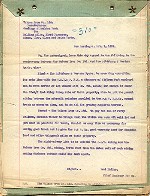
Left: Typical Eyelets Used by a Desktop Eyelet Paper Fastener
Right: 1891 Document with Special Cover Fastened with Eyelets
In the case of many eyelet machine models, the operator mounted eyelets manually one at a time as they were used. Other eyelet machines, such as the IDL Eyeleter pictured below, used strips of eyelets, and yet others, such as the Bates Automatic Eyeleter pictured below, had reservoirs for eyelets that were automatically fed to the point where they were inserted.
In addition to the table-top machines shown on this page, there were hand-held eyelet machines. In fact, nearly all mechanical paper fastening technologies were available in hand-held models.
|
Model, Year, Maker |
Click Image to Enlarge |
Lipman's Patent Improved Eyelet Machine
Patented 1854 (US Patent Nos. 11,027, 11,380) (combination on one stock of punch and fastener)
Patented 1868 (improved fastener, riveting both sides)
Patented 1882 (improved punch for incision in cloth)
Probably marketed by 1856 ~ Exhibited 1860 ~ Advertised 1866-97 ~ Still Sold 1899
Hymen L. Lipman
Lipman Manufacturing Co., Philadelphia, PA (until 1894)
A. A. Weeks, New York, NY (1895-97)
The top piece of this machine is a lever that can be rotated downward 90 degrees to the left or to the right. When the lever is turned to the left (that is, left in the photo), the Punch, which can be seen suspended over the base on the left side, moves downward and cuts a round hole in the papers to be fastened. An eyelet is placed on the base under the Fastener, which can be seen suspended over the base to the right of the Punch. When the lever is turned to the right, the Fastener clinches the eyelet.
This machine was made for fastening paper or cloth; the punch mounted on the machine for cloth was different from that for paper.
In 1854 Hymen L. Lipman (1817-93) was awarded patents for manual and self-feeding eyelet machines that could be used to fasten papers without the operator turning the papers over. According to the 1854 patent:
"In eyelet machines as at present constructed, the eyelet cannot be riveted from one side, and the consequence is that after it is partially riveted from one side [of the document], it must be turned over, and completed. To those who use these machines, this difficulty of turning over the folios is obvious, as they are obliged to let go the sheets to be fastened, and they frequently get out of place."
Advertisements for Lipman's stationer business did not refer to eyelet machines in 1854, but Lipman was selling eyelet machines in 1856, and he manufactured a machine like the one pictured here in 1860. Lipman exhibited eyelet machines at the 1876 Centennial Exhibition in Philadelphia. Lipman was probably the top-selling brand of eyelet machines for fastening papers during the second half of the 19th century. There are records of government purchases of unspecified models of Lipman's eyelet machines during 1863, 1864, 1870, 1879, 1882, 1883, 1891, 1903, and 1906, as well as records of a purchases of Lipman's Indispensable Eyelet Machine in 1886 and Lipman's Improved Eyelet Machine in 1899.
Lipman's 1893 obituary, which discusses his life and many inventions, can be found in The American Stationer, v. 34, Nov. 16, 1893, pp. 992-93. The obituary states that Lipman was the first to produce an eyelet machine in the US and the first to produce a self-feeding eyelet machine anywhere.
|
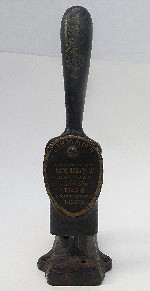
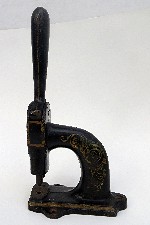 |
Lipman's Patent Self-Feeding Eyelet Machine
Patented 1854 ~ Advertised 1866-67, 1885
H. L. Lipman
Lipman Manufacturing Co.
Philadelphia, PA
The image to the right is from Lipman's 1854 patent for a Self Feeding Eyelet Machine. We do not know whether the self-feeding eyelet machine that Lipman advertised in 1866-67 and 1885 was similar to that in the image in the 1854 patent, but Lipman did not patent any other self-feeding eyelet machine. According to his 1893 obituary, Lipman was the first to produce a self-feeding eyelet machine anywhere.
|
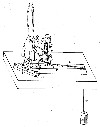
|
Steinmetz Eyeleting Machine (a.k.a. Lipman Unit Eyelet Machine)
Patented 1860 (Steinmetz) ~ Advertised 1886 (Lipman)
William Steinmetz, Philadelphia, PA
H. L. Lipman
Lipman Manufacturing Co.,Philadelphia, PA
The 1860 US patent (No. 27,974) states that this machine will "cleanly cut holes in several thicknesses of paper and then insert eyelets into said holes and clench the same all at one operation."
"Steinmetz," "Philadelphia," and "Pat April 17, 1860" are cast into the helmet of the machine pictured to the right. "Lipman Unit Eyelet Machine" and "Pat. July 25, 1854" are painted on the helmet of another example of this machine.
In 1886 Lipman advertised a Unit Eyelet Machine, which was described as "new." A patent for an eyelet machine was issued to Lipman on July 25, 1854, 32 years before the advertisement; the 1854 patent diagram does not show a machine anything like the one to the left.
We infer that Steinmetz probably marketed the machine in the photo here during the 1860s, although we have found no advertisement for it. We know that Lipman began to market his copy of the machine in 1886, after the Steinmetz patent expired. Presumably Lipman put the date of his expired 1854 patent on the machine simply for marketing purposes.
|
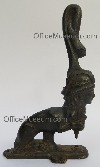
|
Eyelet Machine
Patent 1862 (US Patent No. 35952)
T. K. Reed & H.F. Packard (patent holders)
Bridgewater, MA
This machine was advertised in Scientific American, Jan. 17, 1863, for "inserting eyelets into garments and shoes, in fact into anything in which their presence is required."
|
.jpg) |
Ashcroft's Improved Eyelet Machine
Advertised 1864
John Ashcroft
New York, NY
|
 |
Lipman's Tri-Patent
Eyelet Machine
Patented 1854, 1854, 1865
The two 1854 patents listed on this machine are the same as those listed for Lipman's Patent Improved Eyelet Machine (above).
The 1865 patent, No. 45,727, includes a drawing of this machine.
Advertised 1866-67, 1886-91
H. L. Lipman
Lipman Manufacturing Co.
Philadelphia, PA
The top image is from an advertisement. This ad includes a patent date of 1864. 1864 was the year the patent application was filed, but the patent was awarded on Jan. 3, 1865.
The bottom photo shows a machine in the Elli Buk Collection that was sold at auction in 2013 by Grogan & Co.
|

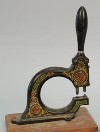 |
Eureka Eyeleting Machine
Patent 1866 (US Patent No. 57446)
George Shipman
Bridgewater, MA.
The upper image to the right is Shipman's 1866 patent diagram for his Eyeleting Machine. The lower image is a photograph of the only known surviving example of Shipman's 1866 Eureka automatic eyelet press. This photograph is posted here with the permission of its creator, The Antikey Chop, who reserves all rights. The photo does not show the foot treadle that powered the machine. As of Oct. 15, 2016, this machine was being offered on eBay: http://www.ebay.com/itm/Antique-EUREKA-EYELET-PRESS-Office-Machine-by-G-Shipman-Boston-Rare-Stapler-/152237107409?hash=item237209e8d1:g:f6cAAOSwOdpX1GRA.
|
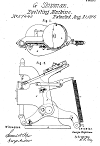
.jpg)
|
Lipman's Indispensable Eyelet Machine (a.k.a. Lipman's Indispensable Tri-Patent Eyelet Machine)
Design Patent 1882 (No. D13,292) ~ Advertised 1886-92
H. L. Lipman
Lipman Manufacturing Co.
Philadelphia, PA

Patent Drawing
|
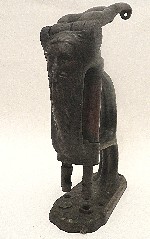
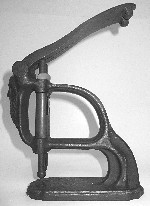 |
Lipman's Combino
Eyelet Machine
Design Patent 1886 (No. D16,844) ~ Advertised 1886-97
H. L. Lipman
Lipman Manufacturing Co.
Philadelphia, PA (1886-89)
A. A. Weeks, New York, NY (1890-97)
This machine was identified as "new" in an 1886 advertisement.
1886 Prices $3 and $4 (two models)
|

|
Eyelet Machine
Advertised 1883
Edwin B. Stimpson & Son
New York, NY
This eyelet machine was advertised for office use.
|
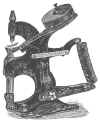 |
Challenge Eyelet Press
No. 1
Introduced 1887 ~ Patented 1887-1907 ~ Advertised 1888-1940 ~ Produced until at least 1961
E. L. Sibley
Subsequently The Edw. L. Sibley Mfg. Co.
Bennington, VT
The model shown was introduced in 1888. The 1887 model was slightly different.
The much larger No. 2 is identical in appearance.
This eyelet machine was advertised until 1940 and the company registered the "Challenge" trademark in 1947. The company was still producing the "old eyelet machine" in 1961, although the company had moved into production of components for missiles and nuclear submarines. The company still existed in 1965. However, as of 2013 the "Challenge" trademark had expired and there was no evidence that the company still existed.
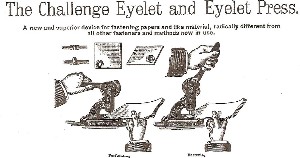
Click on image immediately above to see the original instructions for the Challenge Eyelet Press. |
 |
Perforator, Eyeleter and Tape Binder
Advertised 1888-91
Wyckoff, Seamans & Benedict
Chicago, IL
The tape binder was used to bind manuscripts.
|
 |
Self-Feeding Eyeletting Machine
Advertised 1889
W. E. Cook
London, England
|
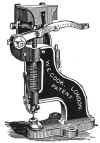 |
Eyelet Closing Press No. 33
Advertised in the 1920s, but the design appears to be older
U.K.
Courtesy of Curtis Scaglione
|
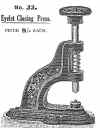 |
| Eyelet Machine
|
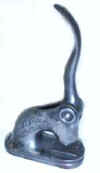 |
Elbe Eyelet Machine No. 1
Advertised 1912-20
Elbe File and Binder Co.
New York, NY
|
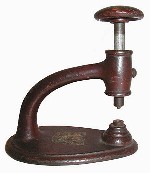 |
Elbe Eyelet Machine No. 2
Elbe File and Binder Co.
New York, NY
|
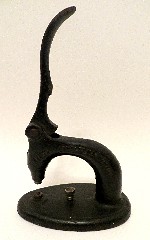 |
Kismet Eyelet Machine
Europe, possibly U.K. |
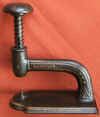 |
Elbe Automatic Eyelet Machine No. 3
Advertised 1912-15
Elbe File and Binder Co.
New York, NY
This machine used a strip of eyelets. |
 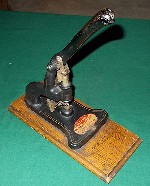 |
Eyelagraph
Advertised 1913
Premo Process Co.
New Brunswick, NJ
This machine has an internal eyelet reservoir.
The similar Premo Automatic Eyelet Machine, made by the Office Utilities Mfg. Co., New
York, NY, was advertised in 1913,
and the similar Stronghold Self-Feeding
Eyeleter, which used a string of 25 eyelets, was advertised in 1915. |
 |
IDL Eyeleter No. 2 (a.k.a. IDL Automatic Eyelet Punch No. 2)
Patented 1915-16 ~ Advertised 1922, 1928-30
R.H. Baxter, New York, NY (1922)
IDL Spec. Mfg. Corp., New York, NY
IDL Mfg. Corp., New York, NY (1928-30)
This machine used strips of eyelets. Two of these strips are shown in the foreground of the photo to the right. Each strip had 15 eyelets. The base of a strip was formed from a sheet of metal. The machine cut eyelets off the strip as the eyelets were used, in the same manner that Hotchkiss strip staplers cut staples off strips.
Also sold as the Star IDL Eyeleter by
The Star Paper Fastener Co., Inc., which was part of the E.H. Hotchkiss Co.
Westport, CT, and New York, NY
The similar Engel Automatic Self-Feeding Eyelet Machine was marketed by the Tower Mfg. and Novelty Co., New York, NY, in 1912. This machine was probably the predecessor of the IDL machine pictured here. In 1913, Arthur F. Engel was awarded US patent No. 1,071,406 for the eyelet strips used by the Engel and IDL machines. |
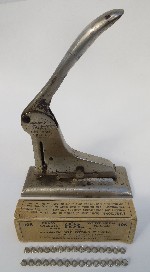 |
Ajax Eyelet Fastener (a.k.a. Bates Ajax Eyelet Fastener, Bates Automatic Eyeleter)
Patented 1916-18 ~ Advertised 1917-23 (Ajax), 1923-26, 1928 (Bates Ajax), 1927 onward (Bates)
Manufactured until 1999
Machine Appliance Corp., New York, NY (Ajax, 1917-23)
Bates Mfg. Co., Orange, NJ (1923-99)
This machine has a reservoir for 150 eyelets. It was sold for 82 years and was widely used for fastening papers.
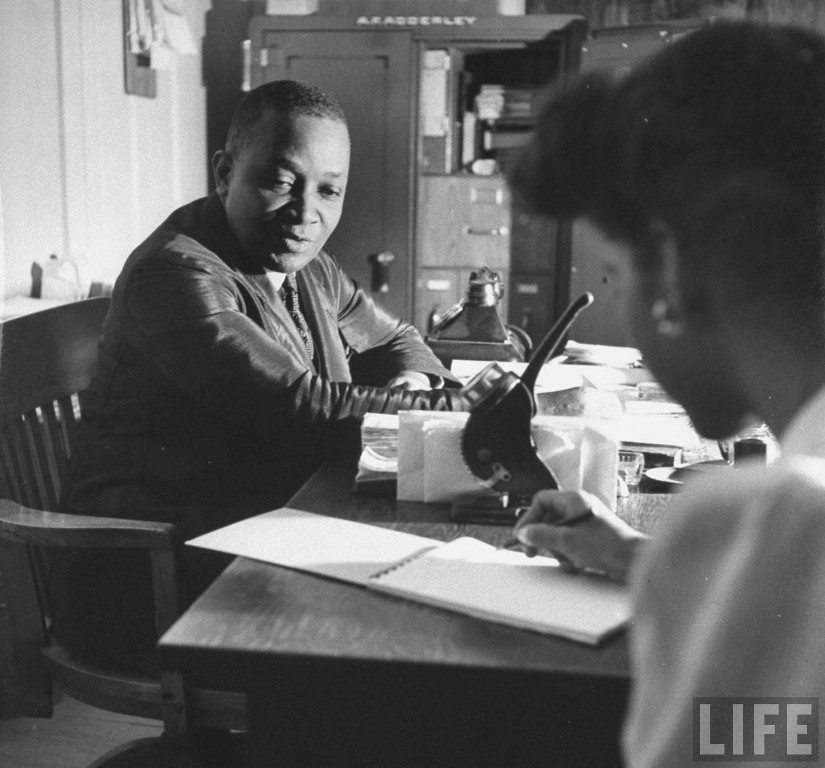
Alfred F. Adderly with Bates Eyelet Fastener, Bahamas, 1943. Mr.
Adderly (1891-1953) was a Bahamas politician.
Photo courtesy of LIFE Photo Archive.
|
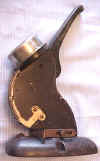
Ajax
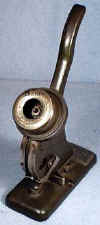
Bates
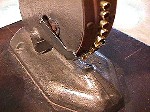
Eyelets Moving Down to Inserter
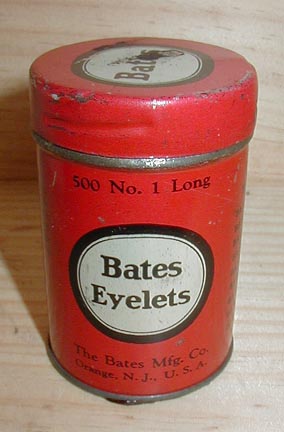
|
Square
Eyeletting Machine
Patented 1914-16 ~ Introduced 1920 ~ Advertised 1920-27
Automatic Pencil Sharpener Co.
Chicago, IL
The machine makes its own eyelets as they are used, punching them from a spool of steel tape that is .005" thick.
|

 |
Return to Top of this Page
|





.jpg)




.jpg)




















